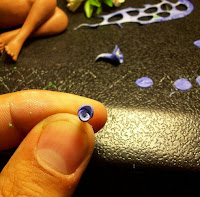I have created a miniature polymer clay figure depicting one of the indigenous figures in one of Camilo Egas’ paintings entitled Fiesta Indigena (1922). Camilio Egas was a painter from Ecuador who was formally trained in the academy there under Paul Bar and Luigi Casadio (a sculptor from Italy). Casadio actually used real Indians in his drawing class which was quite radical at the time. In Ecuador, Egas is the father of indigenismo painting, he is both a modernismo and an indigenismo painter. Indiginismo is when the Indian is used as a symbol of national identity. Egas established an art center called the Egas Art Center, and brought what he learned in Europe home and tried to form many organizations and programs. His figures of Indians tended to be very elongated, long, thin, and exaggerated, yet all the while remaining classical. Egas was not painting his images for an international audience as some other countries of Latin America was doing in the 1920’s but for Ecuadorians themselves. Egas was trying to elevate the Indian as subject matter by referencing the classical past as some way to legitimize what he was doing and so the paintings are reminiscent of Greek Amphora paintings. Just as he ennobled the Indians, I am currently ennobling my art by referencing the (not-so-) distant past. Below are three of Egas’ paintings, the first of which I used the figure engaged with the viewer as my source of inspiration. Click any of the images to see them in a more manageable size.



So, I began working on this by creating the belt that goes around her waist, because the figure was already made, I knew that she needed to look indigenous and that would really be based on her “costume” than features. I used water based acrylic paints atop the clay. Next I made the flowers that were to be hung on the pole the women were holding in the painting. Polymer clay is sometimes seen as a craft material or child’s toy, and flowers are a very popular item to create with it, flowers are insanely easy to make as you see below, for the ruffled flowers, a zig-zag line was drawn in clay and V-shaped petals cut out and arranged around a center. The other flowers were even more easy, they are simply circles cut out with a stray which are then also arranged around each other in your selected color. The clothes on the figure were painted clay, not colored clay, painted clay is more tactile while colored polymer clay is not, the flowers add contrast to that tactile quality because they are colored clay. After painting on the eyes and lips and refining other features, creating a pole that would stand on its own, and attaching the flowers, I was done. I love the result and cant wait to begin the next piece which will be based on the Mexican artist Saturnino Herran.















No comments:
Post a Comment